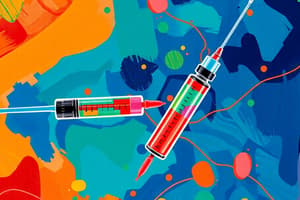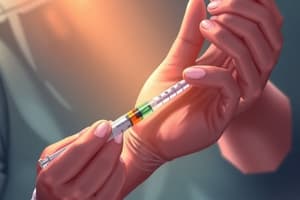Podcast
Questions and Answers
What is meant by parenteral route of medication administration?
What is meant by parenteral route of medication administration?
Medications administered by the parenteral route enter body tissues and the circulatory system by injection, which are absorbed more quickly than oral medications.
When are parenteral routes of medication administration used?
When are parenteral routes of medication administration used?
When patients are vomiting or cannot swallow, when rapid onset of a medication is needed, and/or when patients are restricted from taking oral fluids.
What are the four routes for parenteral administration?
What are the four routes for parenteral administration?
Subcutaneous injection, Intramuscular injection, Intradermal injection, Intravenous injection.
How does one prevent an infection during an injection?
How does one prevent an infection during an injection?
Why do needle stick injuries typically occur? What would assist in preventing them?
Why do needle stick injuries typically occur? What would assist in preventing them?
What is SESIP?
What is SESIP?
What is a syringe? What do Luer-Lok and non-Luer-Lok mean?
What is a syringe? What do Luer-Lok and non-Luer-Lok mean?
How does one know what size needle to use in the syringe?
How does one know what size needle to use in the syringe?
What are needles, and what are their three parts?
What are needles, and what are their three parts?
Why is the bevel tip of a needle always slanted?
Why is the bevel tip of a needle always slanted?
How should one assemble a prefilled syringe?
How should one assemble a prefilled syringe?
What is an ampule?
What is an ampule?
Flashcards are hidden until you start studying
Study Notes
Parenteral Medications Overview
- Parenteral route involves medication administration directly into body tissues or circulatory system through injection, allowing for quicker absorption than oral medications.
- Utilized when patients are unable to swallow, are vomiting, or require rapid medication action; also applicable for those restricted from oral fluids.
Routes of Parenteral Administration
- Subcutaneous Injection: Delivers medication into tissues just below the skin.
- Intramuscular (IM) Injection: Injects medication deep into muscle body.
- Intradermal (ID) Injection: Administers medication into the dermis just under the outer skin layer.
- Intravenous (IV) Injection/Infusion: Delivers medication directly into a vein.
Infection Prevention During Injections
- Contamination of the solution should be avoided; ampules should not remain open, and medication removal should be prompt.
- Use sterile techniques with syringes by preventing needle contact with contaminated surfaces and maintaining cover on syringe tips.
- Prepare the injection site properly and use antiseptic techniques with friction in a circular motion to clean the skin.
- Perform thorough hand hygiene for at least 15 seconds to minimize microorganism transfer.
Needle Stick Injuries
- Primarily caused by recapping needles, mishandling IV lines, or leaving needles unattended.
- To prevent, use sharps containers that automatically lock and consider safety syringes with retractable needles.
- SESIP (Engineered Sharps Injury Protection) devices are designed to minimize risk.
Syringes and Needles
- Syringes are single-use, disposable devices designed for pushing medications into the skin.
- Luer-Lok Syringes: Needles are twisted securely onto the syringe to prevent accidental disconnection.
- Non-Luer-Lok Syringes: Needles slide onto the tip and do not lock.
Choosing Needle Size
- Opt for the smallest suitable syringe size for accuracy; for small doses, use Tuberculin (TB) syringes.
- Needle size selection should also take into account patient size and weight; smaller gauge numbers indicate larger needle diameters.
- Filter needles should not be used for administration purposes.
Needle Structure
- Needles consist of three main parts:
- Hub: Attaches securely to the syringe tip.
- Shaft: Connects the hub to the needle point.
- Bevel: Slanted tip that helps minimize leakage post-injection by creating a narrow slit for medication delivery.
Assembling a Prefilled Syringe
- Insert the cartridge barrel first into the plastic syringe holder.
- Follow manufacturer instructions to secure the plunger rod by turning it until it clicks.
- Remove the needle guard and expel air and excess medication by pushing the plunger.
Ampules
- Sealed glass capsules that contain single-dose medications ready for direct injection. They are typically premeasured for convenience in administration.
Studying That Suits You
Use AI to generate personalized quizzes and flashcards to suit your learning preferences.





